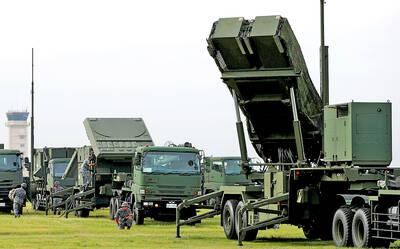Mongolia sealed a long-awaited multibillion-dollar deal with Ivanhoe Mines of Canada and Anglo-Australian miner Rio Tinto yesterday to develop one of the world’s richest copper deposits.
The deal to exploit the Oyu Tolgoi mine was signed by the three parties in a ceremony in the capital Ulan Bator, marking one of the biggest investments in Mongolia since the former Soviet satellite went capitalist two decades ago.
No figure was immediately given for the size of the deal, which was six years in the making, but Mongolia’s minister for mineral resources and energy Dashdorj Zorigt said last month that it was worth US$4 billion.
“This is a significant milestone and we now look forward to working together to develop what I firmly believe is the best undeveloped copper deposit in the world,” Bret Clayton, chief executive of Rio’s Copper and Diamonds group, said in a statement released at the signing.
It said the Mongolian government would own a 34 percent stake in Ivanhoe Mines Mongolia LLC, the project license holder.
The mine in the south Gobi desert will employ as many as 3,000 workers, with thousands more finding jobs along the supply chain, providing a significant boost to the economy of the resource-rich country, one of the poorest in Asia.
Oyu Tolgoi, located about 80km north of the Chinese border, is expected to produce 450,000 tonnes of copper and 330,000 ounces of gold annually over 35 years, Rio Tinto’s statement said.
Mongolia’s GDP — US$5.26 billion last year, World Bank figures show — is expected to increase 34.3 percent over the life of the mine, a 2005 project plan said.
Ivanhoe said it would release an updated plan and financial details after the signing ceremony.
Zorigt, the mineral resource minister, had previously estimated the project could boost Mongolia’s per capita GDP, at about US$1,800 last year, to US$15,000 by 2015.
The deal’s signing comes more than nine years after Ivanhoe started exploration at the Oyu Tolgoi site and six years after it was awarded mining licenses.
Talks had dragged on as Mongolia and Ivanhoe haggled over how big a share the government should take.
Ivanhoe eventually agreed to give the government the 34 percent equity interest and the deal cleared the final hurdle in August when Ulan Bator agreed to scrap a 68 percent windfall tax on copper and gold sales.
Analysts said the deal would provide a “blueprint” for foreign investors wanting to access Mongolia’s rich deposits of copper, gold, uranium, silver and oil.
“This is a pathfinder transaction,” said James McGlew, a senior dealer at Argonaut Securities in Australia. “Hopefully this is the blueprint on how they will develop this part of the economy.”
Rio said it made an initial US$303 million investment for a 9.95 percent stake in Ivanhoe Mines Ltd and has “the obligation to invest 388 million dollars for a further 9.95 percent stake.”
Rio has the option to increase its stake in Ivanhoe Mines to 46.65 percent through fixed-price options and on-market purchases.
It said production was expected to start as early as 2013 with “a five-year ramp-up to full production.”
The Oyu Tolgoi deal is the first of several big contracts the government is hoping to sign.
Next in the pipeline is Tavan Tolgoi, which is said to be the largest untapped coal field in the world. Mining companies and consortiums from Russia, China, South Korea and the US have submitted bids for the project.

MILITARY BOOST: The procurement was planned after Washington recommended that Taiwan increase its stock of air defense missiles, a defense official said yesterday Taiwan is planning to order an additional four PAC-3 MSE systems and up to 500 missiles in response to an increasing number of missile sites on China’s east coast, a defense official said yesterday. The official, who spoke on condition of anonymity, said that the proposed order would be placed using the defense procurement special budget, adding that about NT$1 trillion (US$32,88 billion) has been allocated for the budget. The proposed acquisition would include launchers, missiles, and a lower tier air and missile defense radar system, they said The procurement was planned after the US military recommended that Taiwan increase

POLITICAL AGENDA: Beijing’s cross-strait Mid-Autumn Festival events are part of a ‘cultural united front’ aimed at promoting unification with Taiwan, academics said Local authorities in China have been inviting Taiwanese to participate in cross-strait Mid-Autumn Festival celebrations centered around ideals of “family and nation,” a move Taiwanese academics said politicizes the holiday to promote the idea of “one family” across the Taiwan Strait. Sources said that China’s Fujian Provincial Government is organizing about 20 cross-strait-themed events in cities including Quanzhou, Nanping, Sanming and Zhangzhou. In Zhangzhou, a festival scheduled for Wednesday is to showcase Minnan-language songs and budaixi (布袋戲) glove puppetry to highlight cultural similarities between Taiwan and the region. Elsewhere, Jiangsu Province is hosting more than 10 similar celebrations in Taizhou, Changzhou, Suzhou,

TWO HEAVYWEIGHTS: Trump and Xi respect each other, are in a unique position to do something great, and they want to do that together, the US envoy to China said The administration of US President Donald Trump has told Chinese President Xi Jinping (習近平) “we don’t want any coercion, but we want [the Taiwan dispute] resolved peacefully,” US ambassador to China David Perdue said in a TV interview on Thursday. Trump “has said very clearly, we are not changing the ‘one China’ policy, we are going to adhere to the Taiwan Relations Act, the three communiques and the ‘six assurances’ that were done under [former US president Ronald] Reagan,” Perdue told Joe Kernen, cohost of CNBC’s Squawk Box. The act, the Three Joint Communiques and the “six assurances” are guidelines for Washington

DEEPENING TIES: The two are boosting cooperation in response to China’s coercive actions and have signed MOUs on search-and-rescue and anti-smuggling efforts Taiwan and Japan are moving to normalize joint coast guard training and considering the inclusion of other allies, the Japanese Yomiuri Shimbun reported yesterday. Both nations’ coast guards in June sent vessels to the seas south of the Sakishima Islands to conduct joint training, the report said, adding that it was the second joint maritime training exercise since the nations severed formal diplomatic ties in September 1972. Japan dispatched the Nagoya Coast Guard’s Mizuho, a 134m, 6,000-tonne patrol vessel which can carry a helicopter, while the Coast Guard Administration (CGA) sent the 126m, 4,000-tonne Yunlin, one of its largest vessels, the report